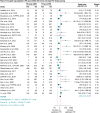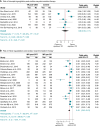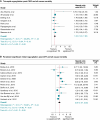Evolution and prognosis of tricuspid and mitral regurgitation following cardiac implantable electronic devices: a systematic review and meta-analysis
- PMID: 38812433
- PMCID: PMC11259857
- DOI: 10.1093/europace/euae143
Evolution and prognosis of tricuspid and mitral regurgitation following cardiac implantable electronic devices: a systematic review and meta-analysis
Abstract
Aims: Significant changes in tricuspid regurgitation (TR) and mitral regurgitation (MR) post-cardiac implantable electronic devices (CIEDs) are increasingly recognized. However, uncertainty remains as to whether the risk of CIED-associated TR and MR differs with right ventricular pacing (RVP) via CIED with trans-tricuspid RV leads, compared with cardiac resynchronization therapy (CRT), conduction system pacing (CSP), and leadless pacing (LP). The study aims to synthesize extant data on risk and prognosis of significant post-CIED TR and MR across pacing strategies.
Methods and results: We searched PubMed, EMBASE, and Cochrane Library databases published until 31 October 2023. Significant post-CIED TR and MR were defined as ≥ moderate. Fifty-seven TR studies (n = 13 723 patients) and 90 MR studies (n = 14 387 patients) were included. For all CIED, the risk of post-CIED TR increased [pooled odds ratio (OR) = 2.46 and 95% CI = 1.88-3.22], while the risk of post-CIED MR reduced (OR = 0.74, 95% CI = 0.58-0.94) after 12 and 6 months of median follow-up, respectively. Right ventricular pacing via CIED with trans-tricuspid RV leads was associated with increased risk of post-CIED TR (OR = 4.54, 95% CI = 3.14-6.57) and post-CIED MR (OR = 2.24, 95% CI = 1.18-4.26). Binarily, CSP did not alter TR risk (OR = 0.37, 95% CI = 0.13-1.02), but significantly reduced MR (OR = 0.15, 95% CI = 0.03-0.62). Cardiac resynchronization therapy did not significantly change TR risk (OR = 1.09, 95% CI = 0.55-2.17), but significantly reduced MR with prevalence pre-CRT of 43%, decreasing post-CRT to 22% (OR = 0.49, 95% CI = 0.40-0.61). There was no significant association of LP with post-CIED TR (OR = 1.15, 95% CI = 0.83-1.59) or MR (OR = 1.31, 95% CI = 0.72-2.39). Cardiac implantable electronic device-associated TR was independently predictive of all-cause mortality [pooled hazard ratio (HR) = 1.64, 95% CI = 1.40-1.90] after median of 53 months. Mitral regurgitation persisting post-CRT independently predicted all-cause mortality (HR = 2.00, 95% CI = 1.57-2.55) after 38 months.
Conclusion: Our findings suggest that, when possible, adoption of pacing strategies that avoid isolated trans-tricuspid RV leads may be beneficial in preventing incident or deteriorating atrioventricular valvular regurgitation and might reduce mortality.
Keywords: Cardiac resynchronization therapy; Conduction system pacing; Implantable cardioverter defibrillator; Leadless pacemaker; Mitral regurgitation; Pacemaker; Tricuspid regurgitation.
© The Author(s) 2024. Published by Oxford University Press on behalf of the European Society of Cardiology.
Conflict of interest statement
Conflict of interest: none declared.
Figures










References
-
- Wang N, Fulcher J, Abeysuriya N, McGrady M, Wilcox I, Celermajer D et al. Tricuspid regurgitation is associated with increased mortality independent of pulmonary pressures and right heart failure: a systematic review and meta-analysis. Eur Heart J 2019;40:476–84. - PubMed
-
- Alnaimat S, Doyle M, Krishnan K, Biederman RWW. Worsening tricuspid regurgitation associated with permanent pacemaker and implantable cardioverter-defibrillator implantation: a systematic review and meta-analysis of more than 66,000 subjects. Heart Rhythm 2023;20:1491–501. - PubMed
-
- Safiriyu I, Mehta A, Adefuye M, Nagraj S, Kharawala A, Hajra A et al. Incidence and prognostic implications of cardiac-implantable device-associated tricuspid regurgitation: a meta-analysis and meta-regression analysis. Am J Cardiol 2023;209:203–11. - PubMed
-
- Al-Bawardy R, Krishnaswamy A, Rajeswaran J, Bhargava M, Wazni O, Wilkoff B et al. Tricuspid regurgitation and implantable devices. Pacing Clin Electrophysiol 2015;38:259–66. - PubMed
Publication types
MeSH terms
LinkOut - more resources
Full Text Sources
Research Materials

